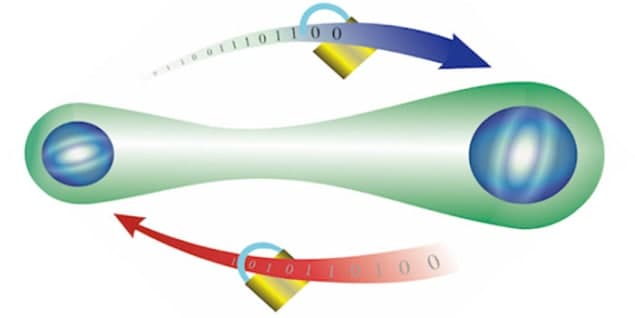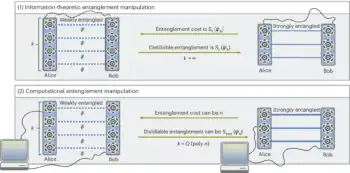
A curious type of nonlocal phenomenon known as one-way quantum steering has been demonstrated experimentally for the first time by two independent groups of physicists. This phenomenon is similar to quantum entanglement but applies when one of the two parties sharing a quantum state does not trust the source of quantum particles. The researchers say their work could help to broaden applications of quantum cryptography.
The idea of quantum nonlocality was first discussed in a famous paper published by Albert Einstein, Boris Podolsky and Nathan Rosen in 1935. The trio described a thought experiment designed to illustrate the inadequacies of Niels Bohr’s interpretation of quantum mechanics, in which an object being measured and the measuring device are regarded as one inseparable whole. Einstein, Podolsky and Rosen argued that either information could travel instantaneously between two points (so apparently contradicting special relativity) or quantum theory was incomplete; in other words, “hidden variables” were needed in addition to the wavefunction to describe physical reality.
As it turned out, Bohr was vindicated. Physicists have gone on to acquire compelling, if not completely watertight, evidence for nonlocality, and have exploited the phenomenon in quantum-communications technology. The most familiar example is quantum entanglement, put forward by Erwin Schrödinger in response to the paper by Einstein and colleagues, in which pairs of quantum particles can be prepared such that even when placed a long way away from each other, a measurement on one of them instantaneously fixes the state of the other. However, there are other forms of nonlocality, including the stronger Bell nonlocality, discovered by the Northern-Irish physicist John Bell, which is inconsistent with the theory of local hidden variables.
Halfway house
In a sense, quantum steering, introduced by Schrödinger, is a halfway house between these other two forms of nonlocality. The two parties involved in a quantum transaction, known traditionally as Alice and Bob, both trust the source of quantum particles when it comes to entangling pairs of those particles. For Bell nonlocality, meanwhile, neither of them trusts the source. But when they do quantum steering, only one of them, let’s say Bob, trusts the source. In this way, Alice can “steer” the state of the particles observed by Bob, which means that measurements she carries out on her half of the entangled particle pairs affect Bob’s state in a way that cannot be explained classically.
If the quantum states employed in steering are symmetrical, then Alice and Bob can steer each other. However, if the states are asymmetrical, then Alice and Bob will not steer one another to the same degree. Indeed, there are some states for which Alice (for example) can steer Bob but not the other way round. This is known as one-way quantum steering.
In 2012 Roman Schnabel and colleagues at the University of Hannover in Germany observed this kind of steering, but they did so only in a limited context – for “Gaussian” measurements carried out on “Gaussian” states. The latest research, in contrast, was designed to demonstrate one-way steering of a given type of state, regardless of the measurements carried out on it.
Tricky problem
The two experiments use similar apparatus to create quantum states from entangled pairs of photons, but they test steering in different ways. Specifically, they take different approaches to the tricky problem of verifying that Bob cannot steer Alice (in addition to showing that Alice can steer Bob). This involves showing that no matter what Bob does to his state, he can never alter Alice’s state in a way that could not be achieved classically. Chuan-Feng Li of the University of Science and Technology of China in Hefei and colleagues did so by specifying that Bob can only ever perform two distinct measurements, while Geoff Pryde and co-workers at Griffith University in Brisbane, Australia, were able to do so for any arbitrary number of measurements.
Li says that one-way steering could find practical applications in asymmetric quantum information. For example, he says, it could be applied to one-way quantum key distribution, which involves creating a secret key that can be used to encrypt and decrypt messages by encoding weak laser pulses in time. This would allow cryptography even if one of the two communicating parties does not trust their measurement device.
Elegant and convincing
Nicolas Brunner of the University of Geneva, whose group last year set out the theory of one-way quantum steering, praises the Chinese and Australian groups for their “elegant and convincing experimental demonstration” of one-way steering. He says that applications of the work “can be envisaged” but believes that a “killer application” still has to be found.
Schnabel agrees that applications are still probably some way off. “For steering in quantum information, it is usually enough to define steering in the desired direction [i.e. Alice to Bob],” he says.
The research is reported in two papers published in Physical Review Letters.



